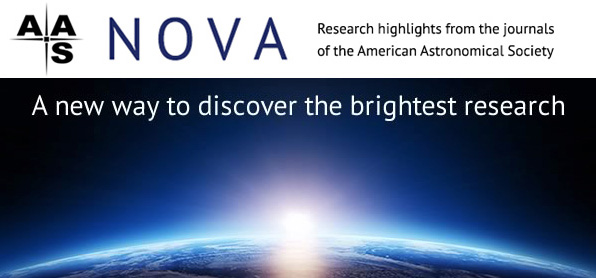Highlights from AAS Nova: 27 November - 10 December 2016

Susanna Kohler American Astronomical Society (AAS)
AAS Nova provides brief highlights of recently published articles from the AAS journals, i.e., The Astronomical Journal (AJ) and The Astrophysical Journal (ApJ), ApJ Letters, and ApJ Supplements. The website's intent is to gain broader exposure for AAS authors and to provide astronomy researchers and enthusiasts with summaries of recent, interesting research across a wide range of astronomical fields.
The following are the AAS Nova highlights from the past two weeks; follow the links to read more, or visit the AAS Nova webpage for more posts.
9 December 2016
Could Flaring Stars Change Our Views of Their Planets?
Our measurements of exoplanet atmospheres may be influenced by the activity of the planets’ host stars.
7 December 2016
Lopsided Collections of Satellite Galaxies
Are small satellite galaxies usually distributed evenly around their larger galactic hosts? Evidence suggests otherwise.
6 December 2016
X-Ray Beasts and Magnetic Fields
Astrobites explores the role of magnetic fields in X-ray emission from the centers of active galaxies.
5 December 2016
Featured Image: A Pulsar Is Obscured by a Solar Explosion
A distant pulsar reveals clues about a phenomenon much closer to home: a coronal mass ejection that erupted from the Sun’s surface.
2 December 2016
Einstein@Home Finds a Double Neutron Star
Have you been contributing your computer idle time to the Einstein@Home project? If so, you’re partly responsible for the program’s recent discovery of a new double-neutron-star system!
30 November 2016
Does the Galactic Bulge Have Fewer Planets?
The Milky Way’s dense central bulge is a very different environment than the galactic disk. Do the differences affect the ability of planets to form there?
29 November 2016
It Turns Out the Sun Is More Chill Than We Previously Thought
Astrobites reports on a closer look at the Sun’s past activity levels.
28 November 2016
Matching Supernovae to Galaxies
A major challenge for modern supernova surveys is identifying the galaxy that hosted each explosion. Is there an accurate and efficient way to do this that avoids investing significant human resources?


